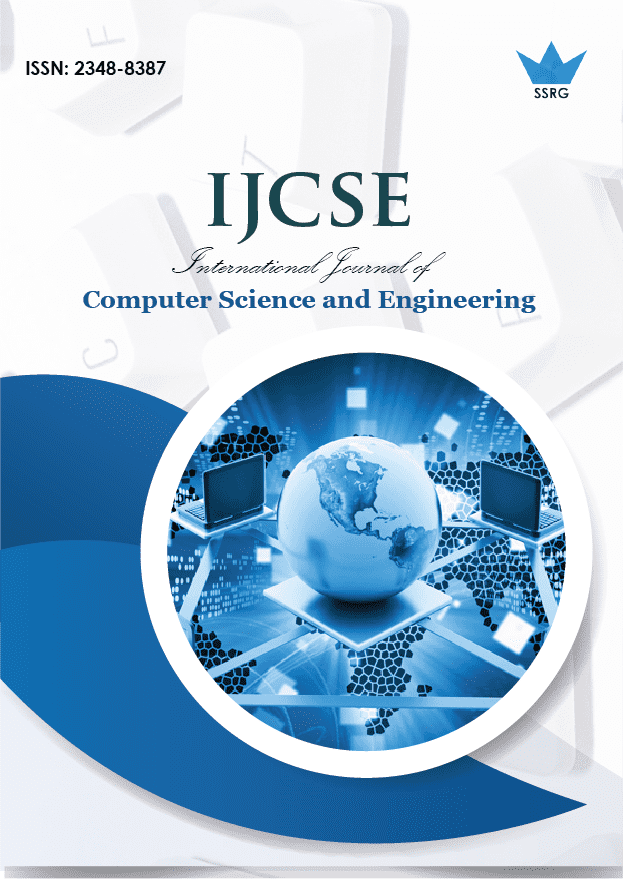Survey on Resume Screening Mechanisms

| International Journal of Computer Science and Engineering |
| © 2022 by SSRG - IJCSE Journal |
| Volume 9 Issue 4 |
| Year of Publication : 2022 |
| Authors : Tumula Mani Harsha, Gangaraju Sai Moukthika, Dudipalli Siva Sai, Mannuru Naga Rajeswari Pravallika, Satish Anamalamudi |
How to Cite?
Tumula Mani Harsha, Gangaraju Sai Moukthika, Dudipalli Siva Sai, Mannuru Naga Rajeswari Pravallika, Satish Anamalamudi, "Survey on Resume Screening Mechanisms," SSRG International Journal of Computer Science and Engineering , vol. 9, no. 4, pp. 14-22, 2022. Crossref, https://doi.org/10.14445/23488387/IJCSE-V9I4P103
Abstract:
Resume Screening is the primary step in the hiring process. It evaluates the candidates' resumes and determines whether they are qualified for a role based on their education, skill sets, technical stuff, experience, and other information captured in their resume. To make it simple, it's a form of pattern that matches the job requirement and the candidate's qualifications based on their resume. It is a crucial step in the process of hiring. It is the step in which a decision is made to move the candidate to the next level or not. There are multiple processes to perform resume screening. Among all the processes, traditional resume or manual screening is the largest followed, even today. But usually, companies receive thousands of resumes for job applications, which consumes a lot of time and effort. In addition to this, many errors may arise due to human involvement. Multiple ways were introduced to cover all these cons to performing this resume screening process. Various technologies, including Artificial Intelligence and Machine Learning, were involved in searching for solutions. This paper contains a detailed survey report on various methodologies and techniques of resume screening.
Keywords:
Resume Screening, Artificial Intelligence, Machine Learning, Hiring.
References:
[1] Rutuja Patil et al., “Resume Evaluation System Based on AI,” International Research Journal of Engineering and Technology, vol. 7, no. 7, pp. 2782-2784, 2020. [Publisher Link]
[2] V. V. Dixit et al., “Resume Sorting using Artificial Intelligence,” International Journal of Research in Engineering, Science and Management, vol. 2, no. 4, pp. 423-425, 2019.
[Google Scholar] [Publisher Link]
[3] Pradeep Kumar Roy, Sarabjeet Singh Chowdhary, and Rocky Bhatia, “A Machine Learning Approach for Automation of Resume Recommendation System,” Procedia Computer Science, vol. 167, pp. 2318-2327, 2020.
[CrossRef] [Google Scholar] [Publisher Link]
[4] Gaurav Dutta, Resume Screening Using Machine Learning, 2021. [Online]. Available:
https://www.kaggle.com/code/gauravduttakiit/resume-screening-using-machine-learning
[5] Resume Screening Using Deep Learning on Cainvas, AI Technologies and Systems, 2022. [Online]. Available: https://medium.com/ai-techsystems/resume-screening-using-deep-learning-on-cainvas-d93f84e65e9c
[6] Aman Kharwal, “Machine Learning Project on Resume Screening with Python,” Resume Screening with Python, 2021.
[7] Fresh Works, Resume Screening - How to Stop Swimming in a Sea of Resumes?, 2016.
[8] Roberto Salazar, Analyzing Candidates Resumes for Jobs Openings, Resume Screening with Python, 2020. [Online]. Available:
https://towardsdatascience.com/resume-screening-with-python-1dea360be49b
[9] Zafar Iqbal et al., “Machine Learning Based Student Grade Prediction: A Case Study,” Computers and Society, 2017.
[CrossRef] [Google Scholar] [Publisher Link]
[10] G. Vadivu, and K. Sornalakshmi, “Applying Machine Learning Algorithms for Student Employability Prediction Using R,” International Journal of Pharmaceutical Sciences Review and Research, vol. 43, no. 1, pp. 38-41, 2017.
[Google Scholar] [Publisher Link]
[11] Byung-Hak Kim, Ethan Vizitei, and Varun Ganapathi, “Gritnet: Student Performance Prediction with Deep Learning,” Machine Learning, 2018.
[CrossRef] [Google Scholar] [Publisher Link]
[12] Jie Xu, Kyeong Ho Moon, and Mihaela Van Der Schaar, “A Machine Learning Approach for Tracking and Predicting Student Performance in Degree Programs,” IEEE Journal of Selected Topics in Signal Processing, vol. 11, no. 5, pp. 742-753, 2017.
[CrossRef] [Google Scholar] [Publisher Link]
[13] Sayantani Ghosh, Sudipta Roy, and Samir K. Bandyopadhyay, “A Tutorial Review on Text Mining Algorithms,” International Journal of Advanced Research in Computer and Communication Engineering, vol. 1, no. 4, 2012.
[Google Scholar] [Publisher Link]
[14] Vishal Gupta, and Gurpreet Lehal, “A Survey of Text Mining Techniques and Applications,” Journal of Emerging Technologies in Web Intelligence, vol. 1, no. 1, 2009.
[Google Scholar] [Publisher Link]
[15] Falguni N. Patel, and Neha R. Soni, “Text Mining: A Brief Survey,” International Journal of Advanced Computer Research, vol. 2, no. 4, pp. 243-248, 2012.
[Google Scholar] [Publisher Link]
[16] Amrut M. Jadhav, and Devendra P. Gadekar, “A Survey on Text Mining and Its Techniques,” International Journal of Science and Research (IJSR), vol. 3, no. 11, 2014.
[17] Kanya Varathan and S. Geetha, “Information Extraction: A Text Mining Approach,” IET-UK International Conference on Information and Communication Technology in Electrical Sciences, pp. 1111- 1118, 2007.
[CrossRef] [Google Scholar] [Publisher Link]
[18] Sholom M. Weiss et al., Text Mining: Predictive Methods for Analyzing Unstructured Information, Springerscience and Business Media, 2010.
[Google Scholar]
[19] S. Liritano, and M. Ruffolo, “Managing the Knowledge Contained in Electronic Documents: A Clustering Method for Text Mining,” 12th International Workshop on Database and Expert Systems Applications, 2001.
[CrossRef] [Google Scholar] [Publisher Link]
[20] Deepshikha Patel, and Monika Bhatnagar, “Mobile SMS Classification,” International Journal of Soft Computing and Engineering (IJSCE), vol. 1, no. 1, pp. 47-49, 2011.
[Publisher Link]
[21] Anushree Negi, “A Brief Survey on Text Mining, Its Techniques, and Applications,” SSRG International Journal of Mobile Computing and Application, vol. 8, no. 1, pp. 1-6, 2021.
[CrossRef] [Google Scholar] [Publisher Link]
[22] Chetan Arora et al., “Automated Checking of Conformance to Requirements Templates Using Natural Language Processing,” IEEE Transactions on Software Engineering, vol. 41, no. 10, pp. 944-968, 2015.
[CrossRef] [Google Scholar] [Publisher Link]
[23] Julia Hirschberg, Bruce W. Ballard, and Donald Hindle, Natural Language Processing,
[24] Minhwa Chung, and D. Moldevan, “Applying Parallel Processing to Natural-Language Processing,” IEEE Expert, vol. 9, no. 1, pp. 36-44, 1994.
[CrossRef] [Google Scholar] [Publisher Link]
[25] B.W. Wah et al., “Report on Workshop on High-Performance Computing and Communications for Grand Challenge Applications: Computer Vision, Speech, and Natural Language Processing, and Artificial Intelligence,” IEEE Transactions on Knowledge and Data Engineering, vol. 5, no. 1, pp. 138-154, 1993.
[CrossRef] [Google Scholar] [Publisher Link]

 10.14445/23488387/IJCSE-V9I4P103
10.14445/23488387/IJCSE-V9I4P103